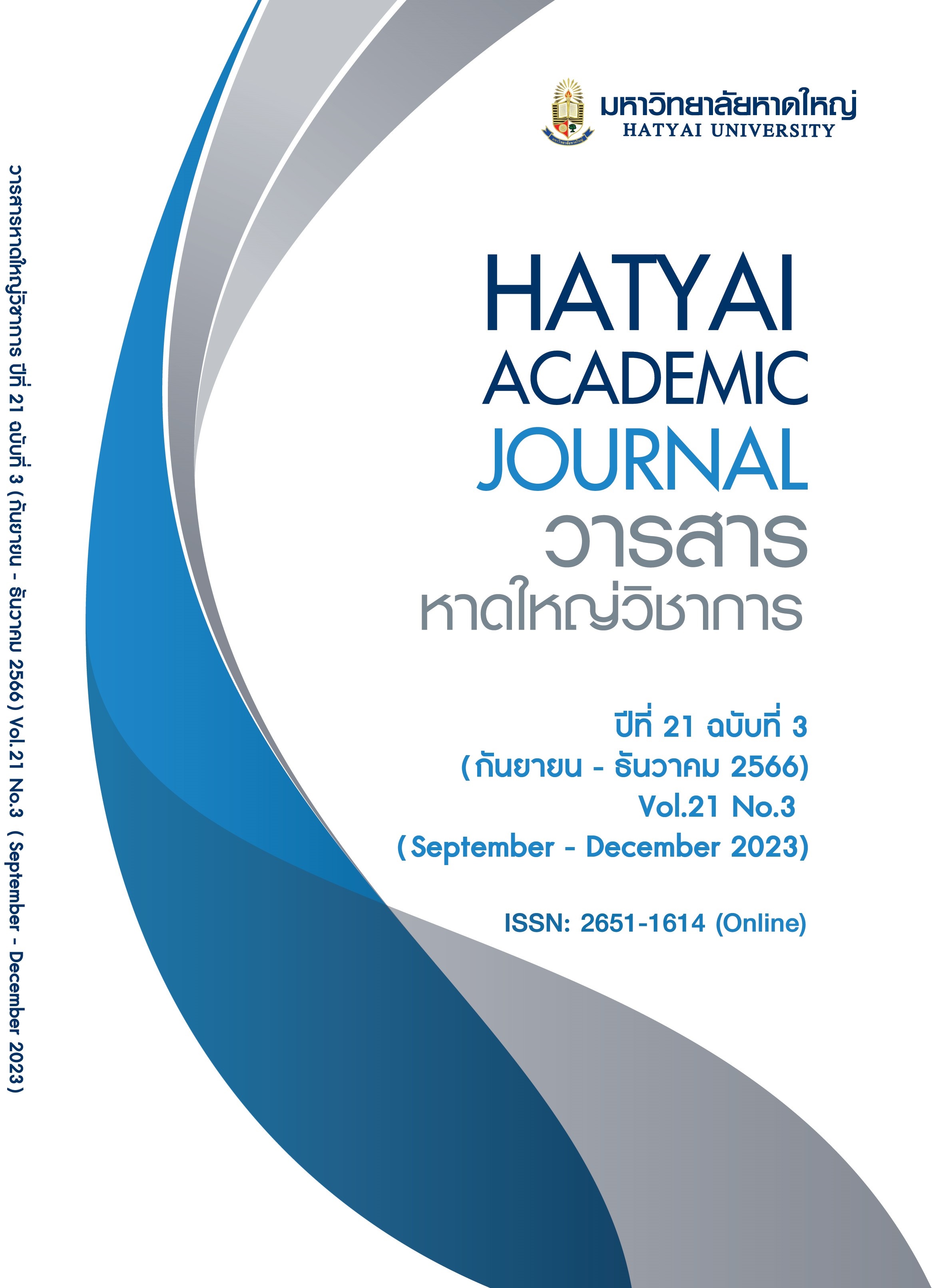Structural Equation Modeling of High-Performance Organizations of the Local Administrative Organizations in Songkhla Province as Perceived by Employees
Main Article Content
Abstract
This study aimed to investigate high-performance organizations in Songkhla Province through structural equation modeling involving the perceptions of employees. The quantitative research method was employed in this study. Questionnaires were used to collect data from 353 employees in local administrative organizations. The data was analyzed by using structural equation modeling (SEM). The findings indicated an adequate fit between the measurement model of high-performance organizations and the observed data (/df = 2.49 RMSEA = 0.065, CFI = 0.99, SRMR = 0.047). The results also revealed that the factors directly affecting organizations with high performance were servant leadership and organizational citizenship behavior with a coefficient effect of 0.60 and 0.24 respectively.
Article Details

This work is licensed under a Creative Commons Attribution-NonCommercial-NoDerivatives 4.0 International License.
All published articles are evaluated by three qualified peer reviewers from various institutions through a double-blind process, where reviewers do not know the authors’ identities and authors do not know the reviewers’ identities. The content and articles in the Hatyai Academic Journal reflect the authors’ views only and are neither the opinions of the editorial board nor the responsibility of Hatyai University. The Editorial Board of the Hatyai Academic Journal allows articles to be reproduced for academic purposes, on the condition that the original source is clearly cited.
References
Angsuchot, S., Wijitwanna, S., & Phinyophanuwat, R. (2011). Analytical statistics for social and behavioral science research: LISREL program techniques. Bangkok: Charoenmankong. [in Thai]
Barbuto, J. E., & Wheeler, D. W. (2006). Scale development and construct clarification of servant leadership. Group & Organization Management, 31(3), 300-326.
Bollen, K. A. (1989). Structural equations with latent variables. New York: John Wiley & Sons.
de Waal, A., & Sivro, M. (2012). The relation between servant leadership, organizational performance, and the high-performance organization framework. Journal of Leadership & Organizational Studies, 19(2), 173-190.
George, D., & Mallery, P. (2010). SPSS for Windows step by step: A simple guide and reference (4th ed.). Boston: Allyn & Bacon.
Hair, J. F. J., Black, W. C., Babin, B. J., & Anderson, R. E. (2010). Multivariate data analysis (7th ed.). New Jersey: Pearson Prentice Hall.
Kittiwimonchai, P., & Sirisuksilp, S. (2016). Characteristics and indicators to become High-Performing Organization (HPO) for higher education case study: Khon Kaen University. Suranaree Journal of Social Science, 10(1), 83-104. [in Thai]
Kline, R. B. (1998). Principles and practice of structural equation modeling. New York: Guilford Press.
Kline, R. B. (2010). Principles and practice of structural equation modeling (3rd ed.). New York: Guilford Press.
Konovsky, M. A., & Organ, D. W. (1996). Dispositional and contextual determinants of organizational citizenship behavior. Journal of Organizational Behavior, 17(3), 253-266.
Lussier, R. N., & Achua, C. F. (2004). Leadership: Theory, application, skill building (2nd ed.). Cincinnati, Ohio: South-Western College.
Melchar, D. E., & Bosco, S. M. (2010). Achieving high organization performance through servant leadership. The Journal of Business Inquiry, 9(1), 74-88.
Nadeem, K., Riaz, A., & Danish, R. Q. (2019). Influence of high-performance work system on employee service performance and OCB: The mediating role of resilience. Journal of Global Entrepreneurship Research, 9(13), 1-13.
Newstrom, J., & Davis, K. (2002). Human behavior at work: Organizational behavior (8th ed.). New Delhi: McGraw-Hill.
Northouse, P. G. (2007). Leadership: Theory and practice (4th ed.). CA: Thousand Oaks.
Nunnally, J. C., & Bernstein, I. H. (1994). Psychometric theory (3rd ed.). New York: McGraw-Hill.
Office of the Decentralization to the Local Government Organization Committee. (2020). Local government organization with good management. Retrieved from https://odloc.go.th/good-management/?fbclid=IwAR0ttCtNakbH4Xk063zM8NdeVkbieilAV0j-ajMrLAWOnkeKx0SEoFYQTZ4 [in Thai]
Oumtanee, A., & Somgiat, B. (2008). Leader-Member Exchange (LMX). Journal of Nursing Science Naresuan University, 1(2), 1-10. [in Thai]
Page, D., & Wong, P. T. P. (2014). A conceptual framework for measuring servant-leadership. Retrieved from https://www.researchgate.net/publication/ 242232213_A_Conceptual_Framework_for_Measuring_Servant-Leadership
Sadeghi, G., Ahmadi, M., & Yazdi, M. T. (2016). The relationship between organizational citizenship behavior and organizational performance (Case study: Agricultural jihad organization of Mazandaran Province). Problems and Perspectives in Management, 14(3), 317-324.
Saikaew, S. (2009). The development of the administrative system of the government inspection of Thailand. King Prajadhipok’s Institute Journal, 7(3), 32-35. [in Thai]
Saleem, F., Zhang, Y. Z., Gopinath, C., & Adeel, A. (2020). Impact of servant leadership on performance: The mediating role of affective and cognitive trust. SAGE Open, 10(1), 1-16.
Singh, J. P., Chand, P. K., Mittal, A., & Aggarwal, A. (2020). High-performance work system and organizational at citizenship behaviour at the shop floor. Benchmarking: An International Journal, 27(4), 1369-1398.
Stevens, J. (2002). Applied multivariate statistics for the social sciences (4th ed.). Mahwah, NJ: Lawrence Erlbaum Associates.
Sutjaritjun, B. (2010). The high performance organization model of nursing college under the ministry of public health (Doctoral dissertation). Silpakorn University, Bangkok. [in Thai]
Viseschoochatkul, N., & Nonthanathorn, P. (2016). The influence of servant leadership and organizational citizenship behavior on effectiveness of patient units as perceived by registered nurses, Pramongkutklao Hospital. Journal of the Association of Researchers, 3(21), 75-85. [in Thai]
Vondey, M. (2010). The relationships among servant leadership, organizational citizenship behavior, person-organization fit, and organizational identification. International Journal of Leadership Studie, 6(1), 3-27.
Yoon, Y., & Uysal, M. (2005). An examination of the effect of motivation and satisfaction on destination loyalty: A structural model. Tourism Management, 26(1), 45-56.

